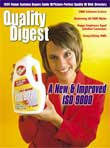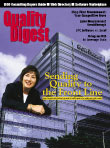 A new & improved ISO 9000
A new & improved ISO 9000
Your ISO 9000:2000 article in the October 1999 issue missed the most important point: cost. When the year
2000 revision is released, all of the other quality system standards worldwide that have ISO 9001 or ISO 9002 embedded in them will have to change to the five-element
scheme. So who is going to pay for this change in the long run? How many suppliers will just give up? How are companies going to survive if they lose important, even critical, suppliers? TC 176 has been told about this concern, but they won't maintain the 20 elements. We in the quality profession have worked hard to get our companies
and suppliers to install quality systems to save us money and supply a better product. Now we'll be taking a big step backward and hurting everything that
we've achieved, because the change is not cost-effective or value-added.
--William Walker First word
I've just read "The Future of Quality," and I'm hopping mad! We quality practitioners in American industry had best wake up to the fact that the
bureaucrats in Brussels, Geneva and wherever else don't pay our salaries--our companies pay us. And I posit that it will be more in our companies' interest to
avert a wholesale rewriting of our quality manuals and systems just to comply with ISO 9000's new four-section arrangement. American manufacturing
realizes that doing it right the first time really does make $ense. The 20-element framework has been battle-proven during the last 10-plus years. Why would
any of us (including the more than 200,000 registered organizations worldwide that you cited) want to redo this willingly? To feather the nests of the world's quality consultants? I think not. Instead, let us concentrate on actually improving the quality of our products and the productivity of our plants and workforces rather than killing more trees in
order to rewrite 200,000 quality manuals!
--Steve Berian As an RAB-registered quality management system auditor, I was dismayed to
read that ISO 9000:2000 "will force the more than 200,000 organizations registered worldwide to rewrite their existing quality manuals."
This is inaccurate or, at a minimum, misleading. The new version of ISO 9001 will not necessarily force organi-zations to rewrite their manuals. Whether a
company rewrites its quality manual and associated documentation depends upon one additional consideration beyond a company's analysis of the new
standard: how the existing manual is structured. Too many companies write quality manuals as a one-to-one mapping, where section 4.1 of their quality
manual maps directly to ISO 9001 section 4.1. This makes it easy for an auditor to audit the documentation and the organization, but lowers the value of the
manual (and the associated quality management system (QMS)) to the organization. A QMS, the manual describing it and the associated
documentation should be mapped so that it is of primary value to the organization, not so that it makes life easy for the auditor. The system should
describe how the organization does business. A simple table included in the manual can provide the mapping between it and ISO 9001 for any auditor.
--Andrew Clark
Shattering QS-9000 myths It was with great interest that I read this piece in the October issue of Quality
Digest. Overall, it was a good article that I will forward to others at my plant. I do, however, question one statement.
As quality manager for a full-service tier one supplier to Ford Motor Co., I can state with conviction that QS-9000 does not replace Ford's quality system
requirements. Q1 is still a separate step in attaining full-service supplier status. Our supplier technical assistance told us that QS-9000 registration wasn't that
big a deal; Q1 was what was important to them. And, in pursuing business with General Motors, one of their first questions was about our willingness to meet
GM's Targets for Excellence requirements. I do agree that most of the Big Three's separate standards have been
streamlined and consolidated under the banner of QS-9000. But as long as these companies continue to require their suppliers to meet individual guidelines, QS-9000 is by no means a replacement.
--Eric Dorow
Electricfil Corp. MIL standards In the October issue of
Quality Digest, you published a letter from George M. Anthony, who was seeking a source for MIL Specs. You might let your readers know that many specs are available for
downloading in PDF (Adobe Acrobat) formatted pages from http://astimage.daps.dla.mil/quick search/. The best part: They're free!
--Carl Sachs
 Sending quality to the front line
Sending quality to the front line
If the article by Susan Peryam in your September 1999 issue is an indication of the state of quality in the banking
industry, banking has a long way to go. Where is the customer? The only mention of the customer is in a paragraph that speaks of the gains realized by the bank, and
there it's a vague reference to reduced errors. Ms. Peryam needs to operationally define customer error. We all know that banks think errors are always our fault.
This article shows that banks still don't understand the essence of quality: customer satisfaction. All the indicators the author speaks about--productivity,
for example--are internally focused. As a bank customer, I don't care about productivity. I care about shorter queue times, lower fees and out-of-state
checks clearing in fewer than five (really six) working days. It's clear that banks still don't get it. But they will when they wake up, like we in
manufacturing did, and realize that quality is not a cost center or a dumping ground for rejects. The customer does matter.
--Tom Frye
I read Susan Peryam's article with enthusiasm; it's good to hear positive results on quality-improvement projects. Sounds like she had to bang her head several
times with executive management to get this project completed, but the bruises were worth the effort. I'm in the quality and compliance areas in the animal and poultry feed
manufacturing business. It seems I fight the same uphill battles with quality improvement, mainly with older managers who say I'm just reinventing the wheel
when I try to get employees involved or utilize process control charting and SPC.
--Blish C. Hills |